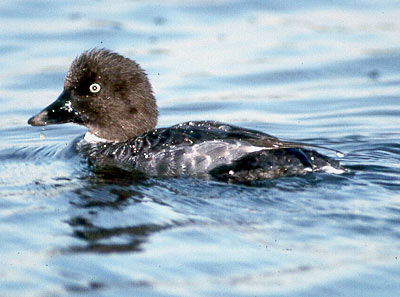
I happen to be looking at female goldeneyes at CAS today. This one appears to be a Common Goldeneye. The size of the bill and the fact that the bill is rough hewn (better term? - lumpy?) are excellent features for Common.Barrow's has small and very smooth bills, somewhat more like those of Buffleheads. The base of the bill/forehead shape seems fine for Common (the bird is perhaps a bit alarmed so forehead looks steeper than it could). The bill color is right for Common and not matched by Barrow's. As bill color goes through it's seasonal changes it appears to occur all at once rather than in sections; e.g., a female Barrow's bill goes from primarily or entirely blackish (fall) to brownish (late fall) to yellow (winter), rather than becoming yellow in sections, so would not show the pattern of Commons and the bird in the image. Finally, the scapulars on Commons average more whitish than on Barrow's age for age, and this one matches an adult Common.
The point I was trying to get at is that immature male goldeneyes of both species have bigger heads than females and I think immature male Common Goldeneyes can be confused with female Barrow's. I feel this bird is actually an immature female because of the dull eye and because the pale near the tip of the bill has not turned pinkish/yellow yet. I raised this point with Pyle who replied:
Yes, by March SY male goldeneyes almost always show some white in the lores and bright white in the scapulars. Also, 1st-year male goldeneyes do not show yellow in the bill, to my knowledge. I look at proportion of the bill as much as true size. A 1st-year male Barrow's still has a proportionally very small (and smoother) bill compared with the head size.
To view public comments or join the fray by adding your opinion, click here. Have fun!
 |
Photo © 1996 Peter LaTourrette. All rights reserved. |